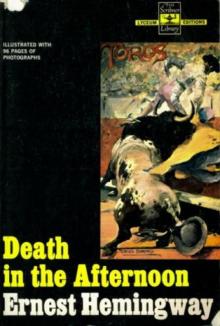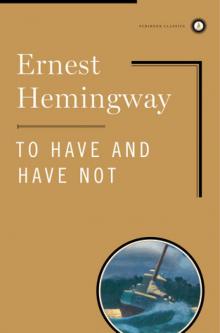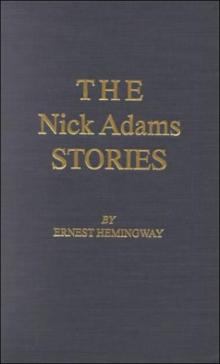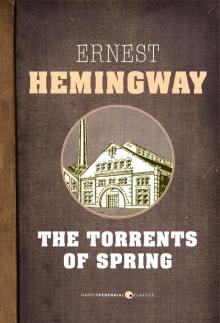- Home
- Ernest Hemingway
By-Line Ernest Hemingway Page 2
By-Line Ernest Hemingway Read online
Page 2
The texts in the collection follow those of the printed versions in their original newspaper and magazine appearances. I have mainly used the original titles, except for certain newspaper headlines which are too long for an anthology of this kind and which are certainly not Hemingway’s in any case. In each instance where a change was made I have included in the table of contents the original headline. (To do otherwise would have caused bibliographical confusion and difficulties for literary historians.) But I have deleted subheads, which were written by newspaper copyreaders purely for typographical purposes to break up long columns of type, and I have quietly (without the use of the academic “sic”) corrected obvious misspellings and typographical errors, regularized capitalization and some punctuation. These are accepted practices for a reading text. For the Toronto selections, a considerable debt is due to W. L. McGeary, librarian of the Toronto Star.
Hemingway’s literary apprenticeship was served in journalism, and his later work in the field earned him money and sent him to places where he wished to be. Yet his enthusiasm, his compassion, and his imagination made such writing far more than just timely stuff. Some readers will no doubt view the material as rounding out the Hemingway record; others, it is to be hoped, will regard it simply as among the best newspaper and magazine reporting available in our troubled times.
WILLIAM WHITE
FRANKLIN VILLAGE, MICHIGAN
February 16, 1967
O N E
Reporting, 1920-1924
Circulating Pictures
The Toronto Star Weekly • FEBRUARY 14, 1920
HAVE you a coming Corot, a modern Millet, a potential Paul Potter or a Toronto Titian temporarily adding whatever the new art adds to your home? If not it is possible to obtain one of the finest works of the moderns for a limited time for a mere fraction of its value.
The Circulating Pictures movement had its genesis in Toronto with Mrs. W. Gordon Mills of 63 Farnham Avenue, who last spring approached one of the foremost Canadian artists with the proposition that she might borrow a picture or two for the summer months. The artist, who is one of those that have introduced anger into art, readily consented and together they discussed the possibility of starting a circulating picture gallery. A number of young married women of Toronto enthusiastically took up the idea and now a gallery of circulating pictures is in full swing, or rather circulation.
According to Mrs. Kenneth T. Young, of 152 Bloor Street West, the circulating gallery is at present a very close corporation. After being asked by a writer for The Star Weekly for a story on the new application of Harvey’s principle of circulation, she talked it over with the other circulatees and they decided that the publication of their names or the names of the artists would give a taint of commercialism to the entire scheme which would quite spoil it. It wouldn’t be nearly so enjoyable to have one or two colorful joyous pictures in your home if you knew that any other responsible person might have them too. Imagine the élan to be derived from the public library if only a dozen or so persons were allowed to make use of it!
The reporter learned, however, that the principle under which the circulating gallery is operating is this: the young matrons select the pictures they wish from the rich, semi-starving or impecunious artists, depending upon the degree of the artist’s modernity and his faculty for advertising, and pay ten per cent of the picture’s assessed value. They then have possession of it for six months. The present scheme has been for each of the young women to have two pictures and after their kick—to use a slang phrase—has worn off, or after it has become so intensified as to make an exchange advisable, to trade with her nearest fellow member of the gallery.
For example, a picture by one of the artists, who, to quote Mrs. Mills, “has introduced anger into art,” might be so potent if hung in the living-room that it might be exchanged after only a few days, perhaps at the husband’s request.
Another might be so powerfully pastoral in motif that the husband might be as easily controlled by it as the cobra by the fakir’s pipes. Such a picture might remain in a home indefinitely, doing yeoman service on the occasion of such domestic incidents as teething, the purchase of spring hats or the discovery of an overdrawn account.
Then there is the painter’s side of it. By this arrangement he receives something at least. His pictures are viewed by many more people and at the end of six months he receives them back ready for sale. But commercialism must not enter in.
A Free Shave
The Toronto Star Weekly • MARCH 6, 1920
THE land of the free and the home of the brave is the modest phrase used by certain citizens of the republic to the south of us to designate the country they live in. They may be brave—but there is nothing free. Free lunch passed some time ago and on attempting to join the Free Masons you are informed it will cost you seventy-five dollars.
The true home of the free and the brave is the barber college. Everything is free there. And you have to be brave. If you want to save $5.60 a month on shaves and hair cuts go to the barber college, but take your courage with you.
For a visit to the barber college requires the cold, naked, valor of the man who walks clear-eyed to death. If you don’t believe it, go to the beginner’s department of the barber’s college and offer yourself for a free shave. I did.
As you enter the building you come into a well-appointed barber shop on the main floor. This is where the students who will soon graduate work. Shaves cost five cents, haircuts fifteen.
“Next,” called one of the students. The others looked expectant.
“I’m sorry,” I said. “I’m going upstairs.”
Upstairs is where the free work is done by the beginners.
A hush fell over the shop. The young barbers looked at one another significantly. One made an expressive gesture with his forefinger across his throat.
“He’s going upstairs,” said a barber in a hushed voice.
“He’s going upstairs,” the other echoed him and they looked at one another.
I went upstairs.
Upstairs there was a crowd of young fellows standing around in white jackets and a line of chairs ran down the wall. As I entered the room two or three went over and stood by their chairs. The others remained where they were.
“Come on you fellows, here’s another one,” called one of the white coats by the chairs.
“Let those work that want to,” replied one of the group.
“You wouldn’t talk that way if you were paying for your course,” returned the industrious one.
“Shut up. The Government sends me here,” replied the non-worker and the group went on with their talking.
I seated myself in the chair attended by a red haired young fellow.
“Been here long?” I asked to keep from thinking about the ordeal.
“Not very,” he grinned.
“How long before you will go downstairs?” I asked.
“Oh, I’ve been downstairs,” he said, lathering my face.
“Why did you come back up here?” said I.
“I had an accident,” he said, going on with the lathering.
Just then one of the non-workers came over and looked down at me.
“Say, do you want to have your throat cut?” he enquired pleasantly.
“No,” said I.
“Haw! Haw!” said the non-worker.
Just then I noticed that my barber had his left hand bandaged.
“How did you do that?” I asked.
“Darn near sliced my thumb off with the razor this morning,” he replied amiably.
The shave wasn’t so bad. Scientists say that hanging is really a very pleasant death. The pressure of the rope on the nerves and arteries of the neck produces a sort of anesthesia. It is waiting to be hanged that bothers a man.
According to the red haired barber there are sometimes as many as one hundred men on some days who come for free shaves.
“They are not all ‘bums’ either. A lot of them take a chance just
to get something for nothing.”
Free barbering is not the only free service to be obtained in Toronto. The Royal College of Dental Surgeons does dental work for all who come to the college at Huron and College streets. The only charge made is for materials used.
Approximately one thousand patients are treated, according to Dr. F. S. Jarman, D.D.S., head of the examination department of the clinic. All the work is done by the senior students under the direction of dental specialists.
Teeth are extracted free if only a local anesthetic is used, but a charge of two dollars is made for gas. According to Dr. Jarman dentists in general practice charge three dollars to extract a single tooth. At the Dental College you can have twenty-five teeth extracted for two dollars! That should appeal to the bargain hunters.
Prophylaxis, or thorough cleaning of the teeth, is done at the college for from fifty cents to a dollar. In private practice this would cost from a dollar to ten dollars.
Teeth are filled if the patient defrays the cost of the gold. Usually from a dollar to two dollars. Bridge work is done under the same system.
No patients are refused at the Dental College. If they are unable to defray the cost of the materials used they are cared for just the same. The person who is willing to take a chance can surely save money on dentistry.
At Grace Hospital across Huron street from the Dental College, there is a free dispensary for the needy poor that gives free medical attention to an average of 1,241 patients a month.
This service is only for the “needy” poor. Those of us who are poor and are not adjudged needy by the social service nurse in charge have to pay for the medical service. According to the figures at the Grace Hospital, over half of the cases treated last month were of Jewish nationality. The others were a conglomeration of English, Scotch, Italian, Macedonian and people of unknown origin.
Free meals were formerly served at the Fred Victor Mission, Queen and Jarvis streets. But the authorities at the mission state that there is almost no demand now. Prohibition and the war solved the “bum” problem and where formerly there was a long queue of “down-and-outs” lined up to receive free meal tickets, there is now only an occasional supplicant.
If you wish to secure free board, free room, and free medical attention there is one infallible way of obtaining it. Walk up to the biggest policeman you can find and hit him in the face.
The length of your period of free board and room will depend on how Colonel [George Taylor] Denison [police magistrate] is feeling. And the amount of your free medical attention will depend on the size of the policeman.
The Best Rainbow Trout Fishing
The Toronto Star Weekly • AUGUST 28, 1920
RAINBOW trout fishing is as different from brook fishing as prize fighting is from boxing. The rainbow is called Salmo iridescens by those mysterious people who name the fish we catch and has recently been introduced into Canadian waters. At present the best rainbow trout fishing in the world is in the rapids of the Canadian Soo.
There the rainbow have been taken as large as fourteen pounds from canoes that are guided through the rapids and halted at the pools by Ojibway and Chippewa boatmen. It is a wild and nerve-frazzling sport and the odds are in favor of the big trout who tear off thirty or forty yards of line at a rush and then will sulk at the base of a big rock and refuse to be stirred into action by the pumping of a stout fly rod aided by a fluent monologue of Ojibwayian profanity. Sometimes it takes two hours to land a really big rainbow under those circumstances.
The Soo affords great fishing. But it is a wild nightmare kind of fishing that is second only in strenuousness to angling for tuna off Catalina Island. Most of the trout too take a spinner and refuse a fly and to the 99 per cent pure fly fisherman, there are no one hundred per centers, that is a big drawback.
Of course the rainbow trout of the Soo will take a fly but it is rough handling them in that tremendous volume of water on the light tackle a fly fisherman loves. It is dangerous wading in the spots that can be waded, too, for a mis-step will take the angler over his head in the rapids. A canoe is a necessity to fish the very best water.
Altogether it is a rough, tough, mauling game, lacking in the meditative qualities of the Izaak Walton school of angling. What would make a fitting Valhalla for the good fisherman when he dies would be a regular trout river with plenty of rainbow trout in it jumping crazy for the fly.
There is such a one not forty miles from the Soo called the—well, called the river. It is about as wide as a river should be and a little deeper than a river ought to be and to get the proper picture you want to imagine in rapid succession the following fade-ins:
A high pine covered bluff that rises steep up out of the shadows. A short sand slope down to the river and a quick elbow turn with a little flood wood jammed in the bend and then a pool.
A pool where the moselle colored water sweeps into a dark swirl and expanse that is blue-brown with depth and fifty feet across.
There is the setting.
The action is supplied by two figures that slog into the picture up the trail along the river bank with loads on their backs that would tire a pack horse. These loads are pitched over the heads onto the patch of ferns by the edge of the deep pool. That is incorrect. Really the figures lurch a little forward and the tump line loosens and the pack slumps onto the ground. Men don’t pitch loads at the end of an eight mile hike.
One of the figures looks up and notes the bluff is flattened on top and that there is a good place to put a tent. The other is lying on his back and looking straight up in the air. The first reaches over and picks up a grasshopper that is stiff with the fall of the evening dew and tosses him into the pool.
The hopper floats spraddle legged on the water of the pool an instant, an eddy catches him and then there is a yard long flash of flame, and a trout as long as your forearm has shot into the air and the hopper has disappeared.
“Did you see that?” gasped the man who had tossed in the grasshopper.
It was a useless question, for the other, who a moment before would have served as a model for a study entitled “Utter Fatigue,” was jerking his fly rod out of the case and holding a leader in his mouth.
We decided on a McGinty and a Royal Coachman for the flies and at the second cast there was a swirl like the explosion of a depth bomb, the line went taut and the rainbow shot two feet out of water. He tore down the pool and the line went out until the core of the reel showed. He jumped and each time he shot into the air we lowered the tip and prayed. Finally he jumped and the line went slack and Jacques reeled in. We thought he was gone and then he jumped right under our faces. He had shot upstream towards us so fast that it looked as though he were off.
When I finally netted him and rushed him up the bank and could feel his huge strength in the tremendous muscular jerks he made when I held him flat against the bank, it was almost dark. He measured twenty-six inches and weighed nine pounds and seven ounces.
That is rainbow trout fishing.
The rainbow takes the fly more willingly than he does bait. The McGinty, a fly that looks like a yellow jacket, is the best. It should be tied on a number eight or ten hook.
The smaller flies get more strikes but are too small to hold the really big fish. The rainbow trout will live in the same streams with brook trout but they are found in different kinds of places. Brook trout will be forced into the shady holes under the bank and where alders hang over the banks, and the rainbow will dominate the clear pools and the fast shallows.
Magazine writers and magazine covers to the contrary the brook or speckled trout does not leap out of water after he has been hooked. Given plenty of line he will fight a deep rushing fight. Of course if you hold the fish too tight he will be forced by the rush of the current to flop on top of the water.
But the rainbow always leaps on a slack or tight line. His leaps are not mere flops, either, but actual jumps out of and parallel with the water of from a foot to five feet. A five-foot jump by any fish
sounds improbable, but it is true.
If you don’t believe it tie onto one in fast water and try and force him. Maybe if he is a five-pounder he will throw me down and only jump four feet eleven inches.
Plain and Fancy Killings, $400 Up
The Toronto Star Weekly • DECEMBER 11, 1920
CHICAGO.—Gunmen from the United States are being imported to do killings in Ireland. That is an established fact from Associated Press dispatches.
According to underworld gossip in New York and Chicago, every ship that leaves for England carries its one or two of these weasels of death bound for where the hunting is good. The underworld says that the gunmen are first shipped to England where they lose themselves in the waterfronts of cities like Liverpool and then slip over to Ireland.
In the Red Island they do their job of killing, collect their contract price and slip back to England. It is said that the price for a simple killing, such as a marked policeman or member of the Black and Tans, is four hundred dollars. It may seem exorbitant when you remember that the old pre-war price in New York was one hundred dollars, but the gunman is a specialist and his prices, like those demanded by prize-fighters, have advanced.
For killing a well-guarded magistrate or other official as much as one thousand dollars is demanded. Such a price for even a fancy killing is ridiculous, according to an ex-gunman I talked with in Chicago.
“Some of those birds are sure grabbing off the soft dough in Ireland. It’s mush to pull a job in that country but trust the boys to get theirs. One job means a trip to Paris.”
It is a fact that there have been more American underworld characters in Paris this summer and fall than ever before. They say that if you throw a stone into a crowd in front of one of the mutuel booths at the famous Longchamps race course outside of Paris, you would hit an American gunman, pickpocket or strong-arm artist.

 The Old Man and the Sea
The Old Man and the Sea Green Hills of Africa
Green Hills of Africa The Sun Also Rises
The Sun Also Rises Death in the Afternoon
Death in the Afternoon In Our Time
In Our Time For Whom the Bell Tolls
For Whom the Bell Tolls A Farewell to Arms
A Farewell to Arms A Moveable Feast
A Moveable Feast The Complete Short Stories of Ernest Hemingway
The Complete Short Stories of Ernest Hemingway Big Two-Hearted River
Big Two-Hearted River Winner Take Nothing
Winner Take Nothing Islands in the Stream
Islands in the Stream To Have and Have Not
To Have and Have Not The Snows of Kilimanjaro and Other Stories
The Snows of Kilimanjaro and Other Stories Across the River and Into the Trees
Across the River and Into the Trees By-Line Ernest Hemingway
By-Line Ernest Hemingway True at First Light
True at First Light Men Without Women
Men Without Women The Nick Adams Stories
The Nick Adams Stories Dateline- Toronto
Dateline- Toronto The Torrents of Spring
The Torrents of Spring Short Stories
Short Stories